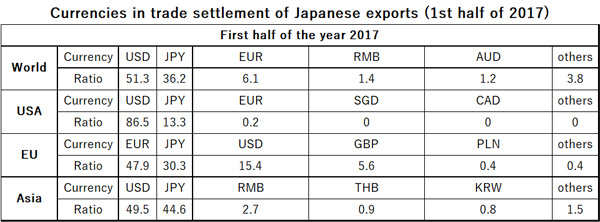Study in Invoice Currencies and Exchange Rate Pass-through
Taiyo Yoshimi
Associate Professor, Faculty of Economics, Chuo University
Area of Specialization: International Finance
What is an invoice currency?
When companies from different countries make trade transactions through imports and exports, they agree on numerous contract terms. “What” (traded products), “how many” (transaction volume), and “how much” (transaction value) would immediately come to mind, but in addition, “which currency to pay in” also forms one of the most important parts of contract terms. This “currency in which the settlement is made” is usually called an invoice currency. The table shows the ratio of each invoice currency in the exports from Japan in the first half of 2017 and was compiled from the data published by Japan Customs. As seen here, numerous currencies – with emphasis on the USD – were used despite the fact that these were exports from Japan.
So why is an invoice currency an important contractual issue? Suppose there is a Japanese company which exports to USA, and a settlement contract for USD10,000 denominated in USD is concluded when USD1 = JPY110. If the Japanese company anticipates the exchange rate to remain stable, the amount denominated in JPY the company expects to receive at the time of concluding the contract will be 1,100,000 yen. Here, let’s imagine that the Japanese yen has appreciated against the US dollar between the time of concluding the contract and the settlement to USD1 = JPY100. In this case, the Japanese company’s received amount denominated in JPY would decrease to 1,000,000 yen but the American importer would pay the same USD10,000 according to the contract. Therefore, in this example, the Japanese company ended up bearing the exchange rate risk. Conversely if the yen depreciates, the Japanese company would naturally receive a higher amount, but considering the exchange rate at the time of settlement cannot be forecasted at the time of concluding the contract, it has to be said that it is still the Japanese company that is bearing the exchange rate risk. This is why the matter of invoice currencies is an important contractual issue, which is directly linked to deciding who will bear the exchange rate risk.
What is exchange rate pass-through?
“Exchange rate pass-through” means the influence that exchange rate fluctuations have on trading prices. As seen from the above example, when the invoice currency is a currency other than that of one’s own country, exchange rate fluctuations are frequently passed through to the trading prices denominated in the currency of one’s own country, and such companies will end up bearing the majority of the exchange rate risks in the short term. I say “in the short term” because in the medium and long term, there is a possibility that the trading prices denominated in the invoice currency will be altered in the view of the fluctuations in the exchange rates. Indeed, based on import data of USA, Gopinath, Itskhoki and Rigobon (2010) found that the influence of exchange rates on the import prices denominated in USD of imported goods that are settled in USD was practically null in the short-term, such as one month, but this rose to about 17% when the effects accumulated over two years were taken into account. This finding shows that the short-term exchange rate pass-through is pretty much decided by the invoice currencies (the exchange rate pass-through over the trading prices denominated in the invoice currency becomes practically null), whereas in the medium to long term, the exchange rate fluctuations are, though partially, actually passed through to the prices denominated in an invoice currency.
Invoice currencies and exchange rate pass-through are important factors that determine the effects that the exchange rates will have on a company’s international operations. For example, the summer 2018 issue of Japan Company Handbook carried a report concerning the influence that 1-yen appreciation could have on Japanese companies’ full-year profit. This report presented the results such as the automobile industry which is highly dependent on the exports being affected negatively (Toyota: -40 billion yen; Nissan: -16 billion yen) and the positive effects on the electricity-related industry which is highly dependent on the imports of oil, etc. (TEPCO: +12 billion yen; Tohoku Electric Power: +3.2 billion yen). What this finding is telling us is the fact that, regardless of the levels of influence according to the industries, it is unlikely that the companies can ignore the influence of exchange rate fluctuations and exchange rate risks. Therefore, the invoice currencies which decide where the exchange rate risk lies, as well as the exchange rate pass-through which indicates the level that exchange fluctuations are passed through to the prices, are also considered to have high political significances.
My research supported by the Grant-in-Aid for Scientific Research, Japan Society for the Promotion of Science
As seen so far, invoice currencies and exchange rate pass-through are arguably of critical importance to the companies’ international operations. In addition, knowing how much exchange fluctuations are passed through to trading prices, and as a result how much influence they will have on trading values and volume, is also rather important from the viewpoint of operating domestic macroeconomic policies that have ripple effects on the exchange rates. Being aware of these issues, since April 2015, I have been working on the project entitled “Invoice Currency and Exchange Rate Pass-through” to work out how invoice currencies and exchange rate pass-through are determined, supported by the Grant-in-Aid for Scientific Research [Grant-in-Aid for Young Scientists (A)]. Through this project, I have been looking into multiple topics related to invoice currencies and exchange rate pass-through. Below is the summary of one of the project’s outcomes: Law, Satoh and Yoshimi (2018).
In this study, we used the price data from the auctions of secondhand construction machines in Japan and Thailand to measure the exchange rate pass-through on individual products. More specifically, we analyzed the influence of exchange fluctuations on the resale prices between the time of purchase and the time of resale of the construction machines that were bought in Japan and resold in Thailand. We observed an asymmetrical exchange rate pass-through, in which the resale prices dropped when THB appreciates against JPY but when it depreciates against yen there was no significant reaction. When THB is strong, even if the sales denominated in THB are low, the purchase prices denominated in JPY can be covered and it would be easy for the brokers to accept the resale prices. Also, for the buyers of the resold goods, dropped prices were blessing and naturally welcomed. On the other hand, increased prices were not easily acceptable for the buyers, therefore even in the period of weaker THB the resale prices did not manage to rise.
Alongside the above-mentioned project assisted by the Grant-in-Aid for Young Scientists (A), I have been working on another project for roughly the same period of time, supported by Grant-in-Aid for Challenging Exploratory Research, entitled “Exchange Rate and Utilization of Free Trade Agreements.” One of the project’s outcome is Hayakawa, Kim and Yoshimi (2017) in which we surveyed the effects of invoice currencies on the correlations between the exchange rates and the use of preferential tariffs in free trade agreements. I will not go into too much details here, but we arrived at the logical conclusion that, in an economy in which the majority of settlements are made in the currencies of importing countries, unexpected depreciation (appreciation) of the currency of the exporting country against that of the importing country increased (decreased) the ratio of preferential tariff usage. Analyzing the preferential tariff usages ratio in the ASEAN-Korea FTA from South Korea’s import data against ASEAN nations also arrived at the result consistent with the logical conclusion above, in that the unexpected drop (increase) in the currencies of the ASEAN nations (exporters) against Korean won (importer currency) resulted in the higher (lower) ratio of the preferential tariff usage.
I am poised to further our researches in the field of international finance including the studies of invoice currencies and exchange rate pass-through, and to contribute to the understanding and development of the economic society.

Source: Share of Currency in Trade, Japan Customs
Note: The numbers in the above table denote the ratio (%) of each currency.
Bibliography
- Gopinath, Gita, Oleg Itskhoki and Roberto Rigobon. 2010. Currency choice and exchange rate pass-through. American Economic Review, Vol.100 (March): 304-336.
Hayakawa, Kazunobu, Han-Sung Kim and Taiyo Yoshimi. 2017. Exchange rate and utilization of free trade agreements: Focus on rules of origin. Journal of International Money and Finance, Vol.75 (July): 93-108.
Law, Kai Po Jenny, Eiji Satoh and Taiyo Yoshimi. 2018. Exchange rate pass-through at the individual product level: Implications for financial market integration. North American Journal of Economics and Finance. Manuscript in Press.
- Taiyo Yoshimi
Associate Professor, Faculty of Economics, Chuo University
Area of Specialization: International Finance - Taiyo Yoshimi serves as Associate Professor in the Chuo University Faculty of Economics and researches international finance.
He was born in Tokyo in 1982, and graduated from the Department of Economics in the Waseda University School of Political Science and Economics in 2005.
He completed the Master’s Program in the Graduate School of Commerce and Management, Hitotsubashi University in 2007
He completed the Doctoral Program in the Graduate School of Commerce and Management, Hitotsubashi University in 2010 and obtained a PhD in commerce and management from the university.
After serving as Assistant Professor and Associate Professor in the Nanzan University Faculty of Economics, he assumed his current position in 2017.
Research website: http://tyoshimi.net/
- Research Activities as a Member of Research Fellowship for Young Scientists (DC1), Japan Society for the Promotion of Science (JSPS) Shuma Tsurumi
- Important Factors for Innovation in Payment Services Nobuhiko Sugiura
- Beyond the Concepts of Fellow Citizens and Foreigners— To Achieve SDGs Goal 10 “Reduce Inequality Within and Among Countries” Rika Lee
- Diary of Struggles in Cambodia Fumie Fukuoka
- How Can We Measure Learning Ability?
—Analysis of a Competency Self-Assessment Questionnaire— Yu Saito / Yoko Neha - The Making of the Movie Kirakira Megane

-
Newest Edition 2019 Autumn Issue
Student journalists report on the students’ take of Chuo University

-
Chuo-DNA
The school's history and motto have been passed on to graduates and students alike. Here is a visualization of Chuo University in the future.Core Energy
Launching Chuo University's Knowledge into Action to the rest of the world, like an infinity of sparkling stars scattered throughout space.
Planned by The Yomiuri Shimbun Business Bureau [PR]















